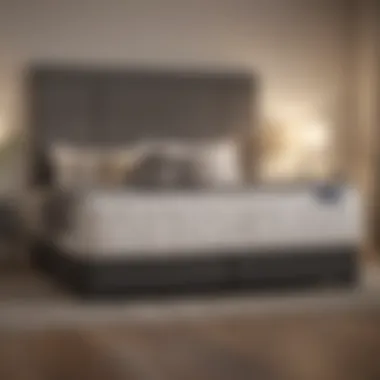Best Buy Beds: Your Guide to Smart Mattress Choices


Intro
Purchasing a bed or mattress can be a significant decision for any homeowner or design enthusiast. This guide aims to assist individuals in navigating the complex mattress and bed market, explaining how to assess various options, prioritize comfort and value, and effectively manage budgets. The insights provided here target not just practical purchasing advice, but also aesthetics and style—factors that interplay heavily in creating harmonious living spaces. By the end of this guide, readers will be equipped with the tools needed to discern what works best for their unique needs and preferences.
Design Inspiration
Trending Styles
The aesthetic appeal of a bed or mattress is crucial. Trends in bed design evolve, influenced by lifestyle changes and technological innovations. Currently, minimalist designs showcase clean lines and simplicity, often accented by natural materials. On the other hand, upholstered beds with plush fabrics offer a sense of luxury and comfort. Moreover, platform beds are gaining traction for their space-saving features and modern look. These styles are often combined with functional elements, allowing for both design and utility.
Color Palettes
Selecting the right color for your bed ensemble can significantly impact the overall vibe of your space. Neutral tones such as gray, white, and beige are popular for their versatility and timelessness. They allow more room for creativity in surrounding decor. Alternatively, deeper hues like navy or forest green can create a striking focal point in a bedroom. When choosing colors, consider the existing palette of your space and ensure a cohesive appearance.
Practical Tips
Maintenance & Care
Maintaining a bed or mattress involves more than just regular cleaning. To prolong the life of your mattress, make sure to rotate it every three to six months. This ensures even wear over time and can prevent sagging. Additionally, investing in a high-quality mattress protector can shield against spills and allergens, keeping your investment in optimal condition. Regularly vacuuming your mattress, and using a mild detergent are simple yet effective care steps.
Budgeting & Planning
Setting a budget before embarking on your bed purchase journey can prevent overspending. Determine the maximum amount you are willing to invest beforehand. Consider additional costs such as bedding accessories, which can add up quickly. Research various retailers and online stores to compare prices. Shopping during sales events or utilizing discount options can also yield substantial savings. Having a clear plan will streamline your purchasing process.
"A well-informed buyer is an empowered buyer. Prioritize what you need for comfort and budget carefully." - Anonymous
By understanding design aspects and practical care tips, you enhance your ability to make informed decisions in the bed market. This guide will unfold further insights into navigating retailers and assessing the myriad of options available to you.
Understanding Bed Types
Understanding the various types of beds is crucial for informed purchasing decisions in the mattress market. Each type of bed offers distinct support, comfort, and durability, which can significantly impact sleep quality. By comprehending these differences, potential buyers can select a bed that aligns with their specific needs and preferences. This section provides an overview of the major bed types, helping you to appreciate the benefits and considerations of each.
Innerspring Beds
Innerspring beds are among the most traditional types on the market. They utilize a coil system for support, which is typically encased in padding or upholstery. The number and arrangement of coils can influence the firmness level and overall support. These beds are often favored for their bounce and the cooling properties they offer due to airflow through the coils. However, they might not provide adequate pressure relief for all sleepers, particularly those who side sleep.
Memory Foam Beds
Memory foam beds are well-known for their contouring abilities. They respond to body heat and pressure, molding to the sleeper's body shape. This quality helps to relieve pressure points and provides support. Memory foam is also effective at minimizing motion transfer, making it a popular choice for couples. However, some users may find these beds retain heat, leading to discomfort for hot sleepers. Additionally, the initial odor from new memory foam can be off-putting but often dissipates over time.
Latex Beds
Latex beds are made from either natural or synthetic latex. They offer a unique combination of support and comfort. This material is elastic, allowing the bed to bounce back after pressure is applied. Latex beds are also known for their durability and hypoallergenic properties, making them an excellent choice for allergy sufferers. While they can be more expensive than other options, the longevity and comfort may justify the investment.
Hybrid Beds
Hybrid beds combine elements from innerspring and foam mattresses. This design often features a coil support system topped with layers of memory foam or latex. This combination aims to deliver the benefits of both worlds: the support and bounce from innerspring systems with the contouring comfort of foam. Hybrid mattresses cater to a wide range of sleep preferences by balancing firmness and cushioning.
Adjustable Beds
Adjustable beds have gained popularity due to their flexibility. These base types allow users to change their position, elevating the head or foot of the bed. This feature can enhance comfort for reading or watching TV in bed and can aid certain medical conditions like sleep apnea or acid reflux. While they can be a larger investment, adjustable beds offer personalized comfort that static beds cannot provide.


In summary, understanding the different bed types plays a foundational role in selecting a mattress that best fits individual requirements. Each type comes with its own set of benefits and potential drawbacks, making it essential to analyze personal sleep habits and preferences before making a decision.
Key Factors in Bed Selection
Choosing a bed is an integral part of ensuring a good night’s sleep and overall health. The right bed can contribute to better sleep quality, which in turn can enhance productivity and well-being during the day. Knowing the key factors in bed selection helps consumers to make informed decisions, balancing comfort, size, longevity, and price. As outlined below, several elements are significant in this decision-making process.
Material Considerations
The material of a bed influences not only its comfort but also its durability and support. Common materials include innerspring, memory foam, latex, and hybrid options. Each material offers distinct benefits:
- Innerspring beds: Known for their bounce and breathability, they tend to be cooler but may not provide the same level of contouring as other materials.
- Memory foam: Offers exceptional contouring and pressure relief, making it suitable for those who value support but can retain heat.
- Latex: Provides a comfortable, responsive feel with natural materials, suitable for eco-conscious consumers.
- Hybrid beds: Combine the best of both innerspring and foam technologies, offering both support and comfort.
These materials significantly impact sleep quality, so understanding their properties is essential in selecting the appropriate bed.
Firmness Levels
Selecting the correct firmness is crucial to achieving comfort and support aligned with personal preferences and sleep positions. Firmness is often categorized as plush, medium, and firm. User preferences differ:
- Plush beds: Provide soft comfort but may not offer enough support for heavier individuals.
- Medium options: Considered the most balanced, often preferable for couples with different preferences.
- Firm beds: Excellent support for back sleepers, but might feel uncomfortable for side sleepers.
Ultimately, firmness level can affect spine alignment and overall sleeping experience.
Size Options
The size of the bed plays a key role in comfort, especially for couples or individuals who move around during sleep. The common sizes include:
Single
A single bed is generally 38 inches wide and 75 inches long. It is an economical choice, suitable for children or single adults. It fits well in smaller spaces, making it a beneficial option for limited areas. However, it may feel cramped for taller individuals.
Full
A full-sized bed measures 54 inches in width and 75 inches in length. It provides more room than a single, making it ideal for solo sleepers who want extra space or couples who do not mind close contact. It's a popular choice, but it still may not suffice for larger individuals or those who toss and turn frequently.
Queen
The queen bed is 60 inches wide and 80 inches long, the most commonly purchased size. It combines space efficiency and comfort, making it suitable for couples or individuals desiring extra room. Its popularity stems from its ability to accommodate various sleeping styles without sacrificing too much bedroom space.
King
A king bed measures 76 inches in width by 80 inches in length. It is ideal for those who seek significant space while sleeping, particularly couples who require room to spread out. Though generous, a king bed also demands more room in a bedroom, which is a consideration for many buyers.
Sleep Position Impacts
People have different sleep positions, and this can significantly impact which bed type is optimal. Side sleepers may require softer materials to cushion their shoulders and hips. Back sleepers often benefit from supportive, medium-firm beds, while stomach sleepers might need firmer options to maintain spinal alignment. Understanding the implications of sleep position is critical in choosing a bed that fosters restorative sleep.
Durability and Lifespan
The longevity of a bed is fundamental in determining its value. High-quality materials usually translate to longer wear. Innerspring mattresses tend to last around 7–10 years, while memory foam and latex can last longer, often reaching up to 10–15 years.
"Investing in a quality bed can lead to a more restful night’s sleep, proving that initial costs are often offset by improved health and productivity."
Choosing wisely, based on these key factors, allows individuals to invest in a bed that will deliver both comfort and value over time.


Budgeting for a Bed Purchase
Budgeting for a bed purchase is a pivotal element in the journey of finding the right mattress and bed frame. It influences all aspects of the buying process, from the selection of options available to the overall satisfaction with your investment. A clear budget helps you navigate through multiple choices and prevents overspending. When you take the time to outline your financial constraints, you can focus on options that align with your needs without getting lost in unnecessary features or flashy designs.
Setting a Price Range
Establishing a price range is the first step in the budgeting process. This range should reflect the maximum you are willing to spend on a bed. Consider what you can realistically afford while still allowing for other household expenses. Generally, a good mattress can cost between $300 to $2,000, depending on factors such as material, brand, and size. Setting a price range not only narrows down your choices but also helps in mitigating the influence of sales pitches that might tempt you to stretch your budget excessively.
Understanding Cost vs. Value
Understanding the distinction between cost and value is crucial. The cost refers to the price you pay for a bed, while value encompasses the quality and longevity of the mattress in relation to its cost. It is essential to look for mattresses that provide good long-term benefits. In some cases, spending a little extra initially can save money over time, as higher-quality products may last longer and offer better support. Researching materials and construction can help identify which beds provide the best value for money, thus leading to a more informed decision.
Signs of Quality
Identifying quality indicators is essential to ensure you are making a sound investment. Here are several signs to consider when evaluating potential purchases:
- Materials Used: High-grade materials such as natural latex or durable memory foam typically indicate a better-quality mattress.
- Warranty Length: A longer warranty often suggests that the manufacturer is confident in their product's durability.
- Thickness and Density: Generally, a thicker mattress with higher density foam can lead to better comfort and support.
- Customer Reviews: Check online reviews and feedback that detail user experiences. High satisfaction rates usually point to a dependable product.
Ultimately, budgeting is not just about limiting spending; it shapes the entire bed-buying experience. A thoughtful approach can lead to a mattress that meets both your comfort requirements and financial expectations.
Where to Buy Beds
When considering a bed purchase, the place of acquisition plays a crucial role. The right store can affect not only the price but also the variety and quality of options available. As consumers become more discerning, understanding the benefits and drawbacks of each buying venue becomes paramount. The choice between local retailers, online stores, warehouse clubs, and second-hand options may significantly influence the ultimate decision regarding a mattress. Each category presents unique advantages, depending on individual preferences and circumstances.
Local Retailers
Local retail stores offer a distinct advantage when it comes to purchasing beds. One of the primary benefits is the ability to try before buying. Shoppers can physically test different mattresses for comfort and support, which is essential given the personal nature of sleep preferences. Many local stores provide knowledgeable sales staff who can guide customers through the selection process based on their specific needs.
Visiting a local store can also foster immediate comparison between models. Shoppers do not have to rely solely on online reviews or descriptions. They can feel the materials, gauge firmness levels, and examine build quality firsthand. Importantly, purchasing locally tends to support community businesses, contributing positively to the local economy.
Online Stores
In today's digital age, online shopping is an increasingly popular option for bed purchases. The convenience of browsing from home cannot be understated. Online platforms often boast a broader selection than many local retailers. Furthermore, users can access reviews and ratings, allowing for more informed decision-making. Websites like Amazon or brand-specific retailers like Saatva and Tempur-Pedic often provide detailed descriptions and comparisons that can aid buyers.
Another significant advantage includes the competitive pricing usually found online. E-commerce stores frequently run promotions and offer lower prices than brick-and-mortar locations. However, it is essential for consumers to consider whether they can tolerate buying without experiencing the product first hand. Many online retailers have generous return policies, which can mitigate some risk.
Warehouse Clubs
Warehouse clubs such as Costco provide an alternative for budget-conscious shoppers. These establishments often sell mattresses at discounted rates, thanks to bulk purchasing agreements. Quality products can be found at lower prices, appealing to consumers who prioritize value without sacrificing comfort. Furthermore, club memberships may offer exclusive deals that can sweeten the deal.
However, shoppers should be prepared for a limited selection in terms of brands and models. While low prices attract many, the options may be less diverse compared to specialized mattress retailers. It is also essential to consider membership fees that may offset the savings. Before purchase, ensure the club's return policy is satisfactory, as some may have restrictive conditions.
Second-Hand Options
Opting for second-hand beds may yield significant cost savings, especially for those on a strict budget. Thrift stores, online marketplaces like Craigslist, or yard sales can offer used mattresses at a fraction of retail prices. This option is particularly appealing to students or anyone looking to furnish a space without breaking the bank.
However, caution is advised when considering second-hand purchases. Hygiene and mattress quality are significant concerns. Buyers should thoroughly inspect any used bed for signs of wear and tear, stains, or pests. Always inquire about the mattress's history and, if possible, request the original purchase invoice. Ensuring the second-hand mattress meets safety regulations is also important.
Choosing where to buy your bed can deeply influence the overall experience. From local stores to online opportunities, each option has merits and drawbacks. Assessing personal priorities—whether comfort, price, or quality—will lead to more satisfactory purchasing decisions.
Sales, Discounts, and Promotions
Sales, discounts, and promotions play a crucial role in making a bed purchase more affordable. Individuals who are navigating the mattress market can significantly benefit from understanding the timing and types of discounts available. These strategies enable consumers to stretch their budgets further while ensuring they obtain quality products.


Retailers frequently host sales during specific seasons or holidays, which can provide substantial savings. Recognizing these opportunities helps buyers plan their purchases effectively and avoid unnecessary costs. Therefore, being aware of upcoming promotions can empower individuals to make smarter buying decisions.
Seasonal Sales Insights
Seasonal sales are an excellent opportunity to acquire a bed at a lower price. Times like Black Friday, Labor Day, or Memorial Day often see significant markdowns on mattresses and bed frames. Retailers typically clear out older inventory to make room for new products, and this creates advantageous conditions for buyers.
- Black Friday: This shopping event may present some of the largest discounts of the year, making it an ideal time to purchase.
- Labor Day Sales: Often considered the end-of-summer shopping event, major retailers return with attractive offers.
- New Year Sales: Stores might also promote beds as part of resolutions for better sleep.
Being proactive and checking multiple sources for sales can lead to better deals. It is also wise to subscribe to newsletters from mattress retailers. This allows consumers to receive exclusive offers and information about upcoming sales directly to their inbox.
Membership Discounts
Some retailers offer membership programs or loyalty plans that can yield additional savings. Membership discounts might come from warehouse clubs like Costco or Sam's Club, where prices on mattresses may be significantly lower for members.
- Costco: Their membership offers discounts on a variety of mattress types, from innerspring to memory foam.
- Sam's Club: Similar to Costco, Sam's Club provides exclusive savings that can lead to substantial savings on premium options.
When purchasing a bed, it is important to compare these exclusive membership deals with regular promotions. This comparison can help identify which route provides better savings.
Testing Before Buying
Before making a substantial investment in a new bed, it is crucial to engage in thorough testing. This phase not only aids in assessing comfort but also enhances the likelihood of long-term satisfaction with your purchase. Understanding different testing methods and being aware of return policies are essential components of the buying process.
In-Store Trial Methods
One of the most effective ways to test a mattress is through an in-store trial method. This approach offers direct feedback on how a bed feels under real-life conditions. It is advisable to spend at least ten to fifteen minutes lying on the mattress in your typical sleeping position. Pay attention to how your body feels; note any pressure points that may arise and consider the mattress's firmness. Another aspect to observe is the edge support; feeling secure when sitting on the side can indicate a quality build.
In addition to how the mattress feels, consider its overall temperature regulation. Beds like memory foam may trap heat, affecting comfort. When testing, ask a sales associate about the materials used in the mattress to understand its cooling properties.
Also, do not hesitate to explore the store's various options. For instance, if you prefer hybrid models, try a few different releases. This not only showcases various designs but can also bring clarity to your personal preferences.
Return Policies
Return policies serve as a safeguard for your investment. They provide a safety net in case the selected bed does not meet expectations after some actual usage at home. Reading the fine print on return policies is crucial before purchasing.
Most retailers offer a trial period ranging from 30 to 120 nights. During this time, it is generally allowed to try the bed in the comfort of your home, ensuring it fits your sleeping habits. Some retailers may charge a fee for returns, while others facilitate free returns, so it is wise to inquire about these costs ahead of time.
Furthermore, understand the conditions for returns. For example, some companies require the mattress to be in its original packaging or demand additional information like purchase receipts to process the return. Familiarize yourself with these stipulations to avoid complications.
In summary, a careful approach to testing beds can prevent regrets. Engage meaningfully with the mattress at the store, and ensure that return policies are favorable and clear. This preparation will lead to a more informed decision, enhancing overall satisfaction with your purchase.
Maintenance and Care of Beds
The maintenance and care of beds is a crucial yet often overlooked aspect of ensuring longevity and comfort in your mattress. Proper upkeep not only extends the lifespan of your bed but also plays a significant role in promoting healthy sleep hygiene. A well-maintained mattress provides better support and comfort, reducing the risk of developing back pain and other sleep-related issues. As beds are an investment in both your health and comfort, understanding how to care for them is essential.
Cleaning Guidelines
Keeping your bed clean is vital. Regular cleaning can help eliminate dust mites, allergens, and odors, ensuring a healthier sleeping environment. Here are some basic guidelines:
- Vacuum Regularly: Use a vacuum cleaner with an upholstery attachment to remove dust and debris from the surface of the mattress. It's best to do this at least once every month.
- Spot Clean Stains: If spills or stains occur, act quickly. Blot the area with a clean cloth and a mixture of mild soap and water. Avoid soaking the mattress.
- Use a Mattress Protector: Protectors can shield your mattress from spills and dirt. They are much easier to wash and maintain than the mattress itself.
- Air Out Your Mattress: Every few months, remove the bedding and allow the mattress to air out. This can help reduce moisture build-up and keep it fresh.
By following these simple guidelines, you can effectively maintain a clean and inviting sleep space.
Replacement Recommendations
Even with the best care, mattresses do not last indefinitely. Recognizing when to replace your mattress is crucial for maintaining sleep quality and health. Here are some recommendations:
- Lifespan Awareness: Generally, it's advisable to replace a mattress every seven to ten years. This can vary depending on the material and usage. For example, memory foam mattresses may begin to sag after several years of use.
- Signs to Look For: Pay attention to signs that your mattress may need replacing, such as uncomfortable lumps, sagging spots, or increased allergies and asthma symptoms.
- Personal Comfort Changes: If you find yourself waking up feeling unrested or experiencing more aches and pains, it may be time to evaluate your bed.
Being proactive about mattress replacement ensures you continue to support your body's needs while also enhancing your overall sleeping experience.















